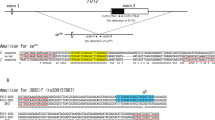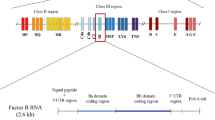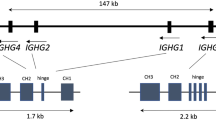Abstract
Many components of complement exhibit inherited structural polymorphism, with at least two alleles being common in one or more of the major races of man1–9. However, definition of genetic polymorphism in human C4 has proved a difficult task. Differences between the electrophoretic patterns of C4 in EDTA plasma from different individuals were detected by Rosenfeld and co-workers10,11, but these differences could not be explained by any simple genetic model. O'Neill and co-workers12, using a system similar to that of a previous study13, interpreted the electrophoretic patterns in a completely different way from previous workers13,14, stating that there were three: F, FS and S. They also found that C4 F carried Rodgers or Rg(a + ) serologie reactivity and C4 S carried Chido or Ch(a + ) reactivity15. These ‘blood group’ antigens had previously been shown to be closely linked to HLA16,17. O'Neill proposed15 that C4 is genetically controlled by two closely linked loci, one for C4 F and one for C4 S, and postulated that deficiency states for one or the other locus are common but rarely occur together. The sets of haplotypes were postulated to be C4Fs° (or C4F), C4f°S (or C4S) and C4FS. In this model, the C4 F individuals are Rg(a +)Ch(a −), C4 S individuals are Rg(a −)Ch(a +) and C4 FS persons are Rg(a +)Ch(a +). The chief problem with the methods of typing, both electrophoretic and serologie, is that C4Fs° and C4f°S can usually only be detected in the homozygous state, thus severely limiting their usefulness. We have now developed a method of C4 typing that allows detection of C4Fs° and C4f°S in heterozygotes, and permits the study of genetic polymorphism of C4 in the general population. Our observations confirm and extend the two-locus genetic model of O'Neill and coworkers.
This is a preview of subscription content, access via your institution
Access options
Subscribe to this journal
Receive 51 print issues and online access
$199.00 per year
only $3.90 per issue
Buy this article
- Purchase on Springer Link
- Instant access to full article PDF
Prices may be subject to local taxes which are calculated during checkout
Similar content being viewed by others
References
Alper, C. A. & Rosen, F. S. in Advances in Human Genetics Vol. 7 (eds Harris, H. & Hirschhorn, K.) 141–188 (Plenum, New York, 1976).
Alper, C. A. & Propp, R. P. J. clin. Invest. 47, 2181–2191 (1968).
Azen, E. A. & Smithies, O. Science 162, 905–907 (1968).
Alper, C. A., Boenisch, T. & Watson, L. J. exp. Med. 135, 68–80 (1972).
Hobart, M. J., Lachmann, P. J. & Alper, C. A. in Protides of the Biological Fluids Vol. 22, (ed. Peeters, H.), 575–580 (Pergamon, New York, 1975).
Raum, D. et al. J. clin. Invest. 64, 858–865 (1979).
Alper, C. A. J. exp. Med. 144, 1111–1115 (1976).
Hobart, M. J. & Lachmann, P. J. Transplantn Rev. 32, 26–42 (1976).
Hobart, M. J., Joysey, V. & Lachmann, P. J. J. Immunogenet. 5, 157–163 (1978).
Rosenfeld, S. I., Ruddy, S. & Austen, K. F. J. clin. Invest. 48, 2283–2292 (1969).
Bach, S., Ruddy, S., MacLaren, J. A. & Austen, K. F. Immunology 21, 869–878 (1971).
O'Neill, G. J., Yang, S. Y., Tegoli, J., Berger, R. & Dupont, B. Nature 273, 668–670 (1978).
Mauff, G., Bender, K. & Fischer, B. Vox Sang. 34, 296–301 (1978).
Teisberg, P., Åkesson, I., Olaisen, B., Gedde-Dahl, T. Jr & Thorsby, E. Nature 264, 253–254 (1976).
O'Neill, G. J., Yang, S. Y. & Dupont, B. Proc. natn. Acad. Sci. U.S.A. 75, 5165–5169 (1978).
Middleton, J. et al. Tissue Antigens 4, 366–373 (1974).
Giles, C. M. et al. Tissue Antigens 8, 143–149 (1976).
Laurell, C.-B. Analyt. Biochem. 15, 45–52 (1966).
Ritchie, R. F., Alper, C. A., Graves, J., Pearson, N. & Larson, C. Am. J. clin. Path. 59, 151–159 (1973).
O'Neill, G. J. & Dupont, B. Transplantn Proc. 11, 1102–1106 (1979).
Hauptmann, G., Grosshans, E. & Heid, E. Ann. Dermatol. Syphilgr. (Paris) 101, 479–496 (1974).
Ochs, H. D. et al. New Engl. J. Med. 296, 470–475 (1977).
Ferreira, A., Nussenzweig, V. & Gigli, I. J. exp. Med. 148, 1186–1197 (1978).
Bitter–Suermann, D., Krönke, M., Brade, V. & Hadding, U. J. Immun. 118, 1822–1826 (1977).
Laurell, C.-B. Analyt. Biochem. 10, 358–361 (1965).
Alper, C. A. & Johnson, A. M. Vox Sang. 17, 445–452 (1969).
Author information
Authors and Affiliations
Rights and permissions
About this article
Cite this article
Awdeh, Z., Raum, D. & Alper, C. Genetic polymorphism of human complement C4 and detection of heterozygotes. Nature 282, 205–207 (1979). https://doi.org/10.1038/282205a0
Received:
Accepted:
Issue Date:
DOI: https://doi.org/10.1038/282205a0
This article is cited by
-
Isotyping of component C4 of human complement using differences in the functional activity of isotypes C4A and C4B
Russian Journal of Bioorganic Chemistry (2000)
-
Complotypes in individuals of African origin: frequencies and possible extended MHC haplotypes
Immunogenetics (1990)
-
Quantitative variation of C4 variant proteins associated with many MHC haplotypes
Immunogenetics (1989)
-
Quantitation of human C4A and C4B, in serum and plasma by enzyme-linked immunoadsorbent assay
Immunogenetics (1988)
-
The complement system in Type 1 (insulin-dependent) diabetes
Diabetologia (1987)
Comments
By submitting a comment you agree to abide by our Terms and Community Guidelines. If you find something abusive or that does not comply with our terms or guidelines please flag it as inappropriate.



